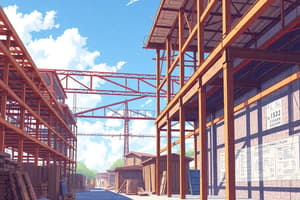Podcast
Questions and Answers
What is the primary purpose of connectors in steel framing?
What is the primary purpose of connectors in steel framing?
- To provide insulation against thermal bridging
- To provide structural support
- To form the wall frames
- To connect studs to tracks and to each other (correct)
Which type of steel framing is suitable for high-rise buildings and commercial construction?
Which type of steel framing is suitable for high-rise buildings and commercial construction?
- Heavy-gauge steel framing (correct)
- Light-gauge steel framing
- Steel framing with thermal insulation
- Steel framing with corrosion protection
What is a major advantage of steel framing over traditional wood framing?
What is a major advantage of steel framing over traditional wood framing?
- Increased risk of corrosion
- Faster speed of construction (correct)
- Lower upfront cost
- Reduced energy efficiency
What is a potential disadvantage of steel framing in coastal or humid environments?
What is a potential disadvantage of steel framing in coastal or humid environments?
What is a benefit of steel framing in terms of sustainability?
What is a benefit of steel framing in terms of sustainability?
What is the term for the phenomenon of heat being conducted through steel framing, reducing energy efficiency?
What is the term for the phenomenon of heat being conducted through steel framing, reducing energy efficiency?
What is the present tense of 'to be' for the subject 'I'?
What is the present tense of 'to be' for the subject 'I'?
What is the past tense of 'to have' for the subject 'he'?
What is the past tense of 'to have' for the subject 'he'?
What is the present tense of 'to do' for the subject 'they'?
What is the present tense of 'to do' for the subject 'they'?
What is the future tense of 'to go' for the subject 'we'?
What is the future tense of 'to go' for the subject 'we'?
What is the past tense of 'to make' for the subject 'it'?
What is the past tense of 'to make' for the subject 'it'?
Flashcards are hidden until you start studying
Study Notes
Steel Framing
Definition
- Steel framing refers to a construction method that uses steel studs and tracks to form the structural skeleton of a building.
Components
- Studs: vertical steel members that form the wall frames
- Tracks: horizontal steel members that form the top and bottom plates of the wall frames
- Connectors: used to connect studs to tracks and to each other
Types of Steel Framing
- Light-gauge steel framing: uses thin, lightweight steel members (typically 0.5-2 mm thick)
- Suitable for low-rise buildings, residential construction, and non-load bearing walls
- Heavy-gauge steel framing: uses thicker, heavier steel members (typically 2-6 mm thick)
- Suitable for high-rise buildings, commercial construction, and load-bearing walls
Advantages
- Speed of construction: steel framing is generally faster than traditional wood framing
- Strength and durability: steel framing provides high strength-to-weight ratio and resistance to natural disasters
- Cost-effectiveness: steel framing can be more cost-effective than traditional wood framing
- Sustainability: steel is 100% recyclable and can be reused in other construction projects
Disadvantages
- Higher upfront cost: steel framing can be more expensive than traditional wood framing
- Corrosion risk: steel framing requires proper protection against corrosion, especially in coastal or humid environments
- Thermal bridging: steel framing can conduct heat, reducing energy efficiency if not properly insulated
Studying That Suits You
Use AI to generate personalized quizzes and flashcards to suit your learning preferences.




